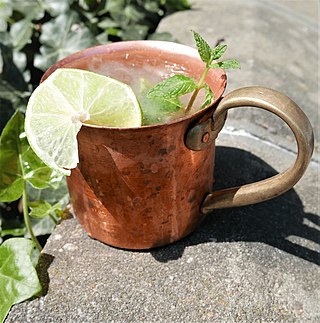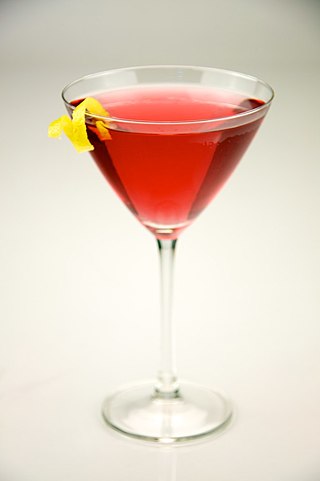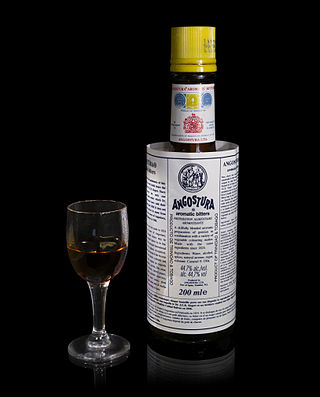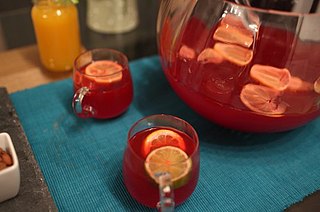
A cocktail is a mixed drink, usually alcoholic. Most commonly, a cocktail is a combination of one or more spirits mixed with other ingredients, such as juices, flavored syrups, tonic water, shrubs, and bitters. Cocktails vary widely across regions of the world, and many websites publish both original recipes and their own interpretations of older and more famous cocktails.

A gin and tonic is a highball cocktail made with gin and tonic water poured over a large amount of ice. The ratio of gin to tonic varies according to taste, strength of the gin, other drink mixers being added, etc., with most recipes calling for a ratio between 1:1 and 1:3. It is usually garnished with a slice or wedge of lime. To preserve effervescence, the tonic can be poured down a bar spoon. The ice cools the gin, dulling the effect of the alcohol in the mouth and making the drink more pleasant and refreshing to taste.

The Harvey Wallbanger is a mixed drink made with vodka, Galliano, and orange juice. It is a variant of the screwdriver, and was very popular in the United States in the 1970s.

A Moscow mule is a cocktail made with vodka, ginger beer and lime juice, garnished with a slice or wedge of lime, and a sprig of mint. The drink, being a type of buck, is sometimes called vodka buck. It is popularly served in a copper mug, which takes on the cold temperature of the liquid.

A bitters is traditionally an alcoholic preparation flavored with botanical matter for a bitter or bittersweet flavor. Originally, numerous longstanding brands of bitters were developed as patent medicines, but now are sold as digestifs, sometimes with herbal properties, and as cocktail flavorings.

The martini is a cocktail made with gin and vermouth, and garnished with an olive and/or a lemon twist. Over the years, the martini has become one of the best-known mixed alcoholic beverages. A common variation, the vodka martini, uses vodka instead of gin for the cocktail's base spirit.

A cosmopolitan, or, informally, a cosmo, is a cocktail made with vodka, Cointreau, cranberry juice, and freshly squeezed or sweetened lime juice.

A sour is a traditional family of mixed drinks. Sours belong to one of the old families of original cocktails and are described by Jerry Thomas in his 1862 book How to Mix Drinks.

Angostura bitters is a concentrated bitters based on gentian, herbs, and spices, produced by House of Angostura in Trinidad and Tobago. It is typically used for flavouring beverages, or less often, food. The bitters were first produced in the town of Angostura, hence the name, but do not contain angostura bark. The bottle is recognisable by its distinctive oversized label and yellow cap. Angostura is Spanish for "narrowing", the town of Angostura having been at the first narrowing of the Orinoco River.

The gimlet is a cocktail made of gin and lime cordial. A 1928 description of the drink was: gin, and a spot of lime. A description in the 1953 Raymond Chandler novel The Long Goodbye stated that "a real gimlet is half gin and half Rose's lime juice and nothing else." This is in line with the proportions suggested by The Savoy Cocktail Book (1930), which specifies one half gin and one half lime juice. However, some modern tastes are less sweet, and generally provide for up to four parts gin to one part lime cordial.
Flavored liquors are liquors that have added flavoring and, in some cases, a small amount of added sugar. They are distinct from liqueurs in that liqueurs have a high sugar content and may also contain glycerine.

The Fine Art of Mixing Drinks is a book about cocktails by David A. Embury, first published in 1948. The book is noteworthy for its witty, highly opinionated and conversational tone, as well as its categorization of cocktails into two main types: aromatic and sour; its categorization of ingredients into three categories: the base, modifying agents, and special flavorings and coloring agents; and its 1:2:8 ratio for sour type cocktails.

A "fizz" is a mixed drink variation on the older sours family of cocktail. Its defining features are an acidic juice and carbonated water. It typically includes gin or rum as its alcoholic ingredient.

A highball is a mixed alcoholic drink composed of an alcoholic base spirit and a larger proportion of a non-alcoholic mixer, often a carbonated beverage. Examples include the Seven and Seven, Scotch and soda, gin and tonic, screwdriver, fernet con coca, Tom Collins, and rum and Coke. A highball is typically served over ice in a large straight-sided highball glass or Collins glass.

A Bloody Mary is a cocktail containing vodka, tomato juice, and other spices and flavorings including Worcestershire sauce, hot sauces, garlic, herbs, horseradish, celery, olives, pickled vegetables, salt, black pepper, lemon juice, lime juice and celery salt. Some versions of the drink, such as the "surf 'n turf" Bloody Mary, include shrimp and bacon as garnishes. In the United States, it is usually consumed in the morning or early afternoon, and is popular as a hangover cure.
The Blackthorn is an Irish whiskey or sloe gin based cocktail. Both versions emerged in the late 19th and early 20th century.

Chapman is a non-alcoholic drink, usually red in colour. Often referred to as a non-alcoholic punch, it is traditionally made with a mix of Fanta, Sprite, Cucumber, Lemon, Grenadine and Angostura bitters and is traditionally served in a large mug with ice and a few slices of cucumber. It is often described as Nigeria's favourite drink and though predominantly served without alcohol, it can also be served with a hint of vodka or rum.

The Martinez is a classic cocktail that is widely regarded as the direct precursor to the Martini. It serves as the basis for many modern cocktails, and several different versions of the original exist. These are generally distinguished by the accompaniment of either Maraschino or Curacao, as well as differences in gin or bitters.
















